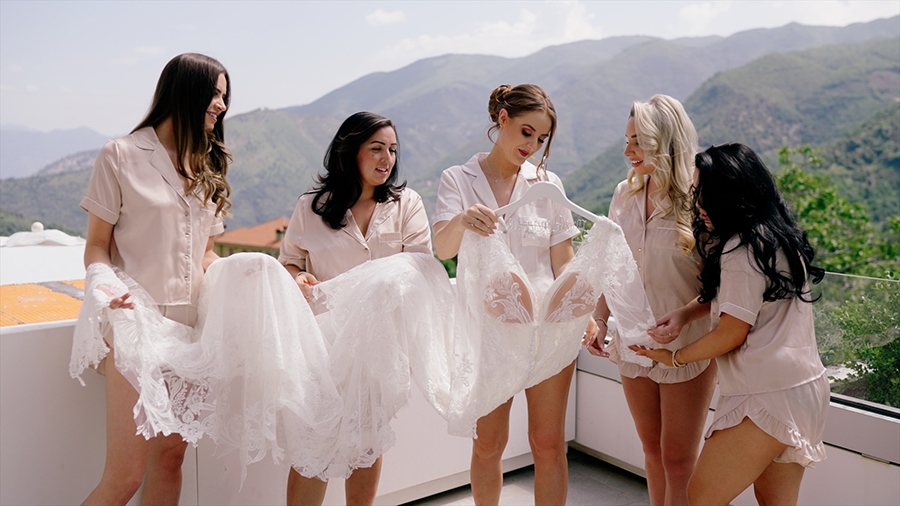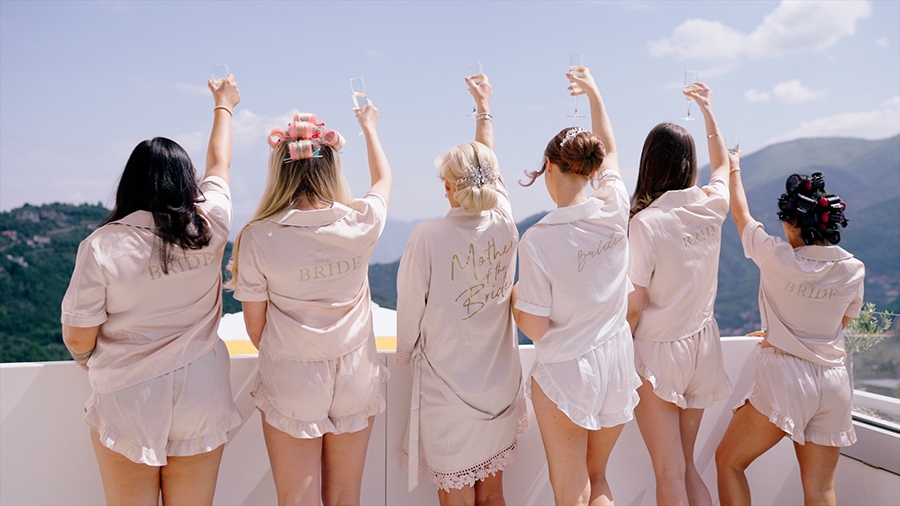Exploring the history and roots of the bridesmaid tradition proves beneficial for both the bride and the designated person, shedding light on the importance and duties of this figure during the wedding. In the Italian tradition, this figure has undergone an evolution, due to the influence of different cultures.
Therefore, in this article we will delve into the historical development of the bridesmaid and her role which has acquired increasing significance over time, entailing a series of responsibilities and behavioral norms for those who hold this role.
How Should the Bridesmaid Dress?

In addition to the responsibilities that this role entails in the story, what distinguishes the bridesmaid is the elegant ceremonial dress she will wear. Every woman deserves the freedom to express her personality through an outfit and especially makeup that makes her feel at ease.
For further information on how to choose the most suitable makeup to enhance yourself, you can read our previous article on How to choose wedding makeup: Tips and tricks for a perfect look.
However, it is essential to underline that in a wedding the bride has the final say on the bridesmaid’s dress. Therefore, her dress must be complementary to that of the bride, certainly less elaborate and inconspicuous, so as not to ruin the central figure of the bride.
If the wedding adheres to a specific color theme, it’s best for the bridesmaid to wear a dress that aligns with the same hue as the event.
What are the Duties of the Maid of Honor?

According to history, the term “ bridesmaid ” has its roots in the Old French “dameisele” (modern: demoiselle), derived as a diminutive form of “dame.” Originally, it served as an honorific for the wives of humble gentlemen and untitled squires. Over time, its use expanded to include young women of noble lineage, and maidens in the service of princesses and nobility, who sometimes filled the role of maid. The term “maid of honor” emerged specifically in the context of wedding ceremonies.
In addition to helping the bride with wedding preparations, the bridesmaid carries out specific tasks both during the ceremony and during the reception. Regarding her role in the ritual, it is essential to understand that she must coordinate any other bridesmaids and page boys, providing guidance on their actions at appropriate times. Additionally, she is responsible for arranging the bride’s dress and veil as the bride approaches the altar. Throughout the banquet and celebrations, she remains ready to handle any unforeseen circumstances while maintaining a discreet profile, as the main emphasis should, of course, always be on the bride.
The History of the Bridesmaid: The Origins of the Tradition
After having clarified the birth and development in the history of the role of the bridesmaid in weddings and her fundamental role as support of the bride on her most significant day, we explore the origins of this tradition in the world, tracing its roots from its beginning up to ‘contemporary era.
Egyptian origins
Steeped in superstition, the concept of the bridesmaid has its origins in ancient Egyptian history. During the era of this great kingdom, there was a belief in evil spirits with a particular aversion to brides. Fearing that these “attendances” might sabotage the success of the wedding, the bride’s friends adopted the habit of dressing like her to confuse potential transgressors. In some cases, it was only a single bridesmaid who wore a dress strikingly similar to that of the bride, marking the first manifestations of the birth of this role in history.
Ancient Rome
Traces of this belief also emerged in ancient Rome, where a law required the presence of at least ten witnesses at a wedding to outwit the evil spirits mentioned in Egyptian tradition. Likewise, in Italy, both bridesmaids and groomsmen were dressed like the couple to ward off curses.
Victorian age
The tradition of dressing groomsmen and bridesmaids similarly to the bride has lasted many centuries. In fact, in some Victorian wedding photographs, it is very difficult to distinguish the bride and groom.
Throughout history, bridesmaids evolved into symbols of the social status of the bride’s family: the more friends the bride could afford to display in public, the more she signaled wealth to high society. The image of a long procession of young girls presents conveyed power and influence.
The Evolution of the Figure of the Bridesmaid in Contemporary History
This tradition is firmly rooted in the United States and England, where there is usually a full wedding procession, involving so-called bridesmaids, and adult women with a close bond with the bride. Among them is the maid of honor, who often acts as both best man and key figure, accompanied by groomsmen and friends of the groom. In the tradition of Anglo-Saxon history, it is customary for the bridesmaid to be single, in order to potentially find her future groom during the event.
In contrast, Italian tradition includes the inclusion of bridesmaids and page boys, children with a special bond with the couple who perform specific tasks during the ceremony. The bridesmaids, generally there can be two to six, wear coordinated dresses which, at most, differ in color. Likewise, an equal number of page boys should be dressed elegantly and in keeping with the ceremony, with one typically tasked with delivering the wedding rings at the appropriate time.
However, Italian customs were influenced by Anglo-Saxon and American culture. Consequently, alongside or instead of bridesmaids and page boys, the maid of honor is becoming increasingly common in Italian weddings.
In conclusion
The role of the bridesmaid represents a distinctive and significant tradition, which throughout history, evolved across different cultures. Given its origins, it is evident that this figure plays a vital role in supporting the bride and contributing to the overall atmosphere of the wedding ceremony.
From Egyptian superstitions to modern practices, the bridesmaid has not only retained its meaning but has also adapted to reflect the values and preferences of the contemporary age. The interaction between tradition and individual expression, especially in the choice of an elegant formal dress, and makeup that enhances the woman, shows the evolving nature of this role. Whether you stick to strict customs or take a more personalized approach, the maid of honor remains a symbol of friendship, support, and joy during one of life’s most significant milestones.



